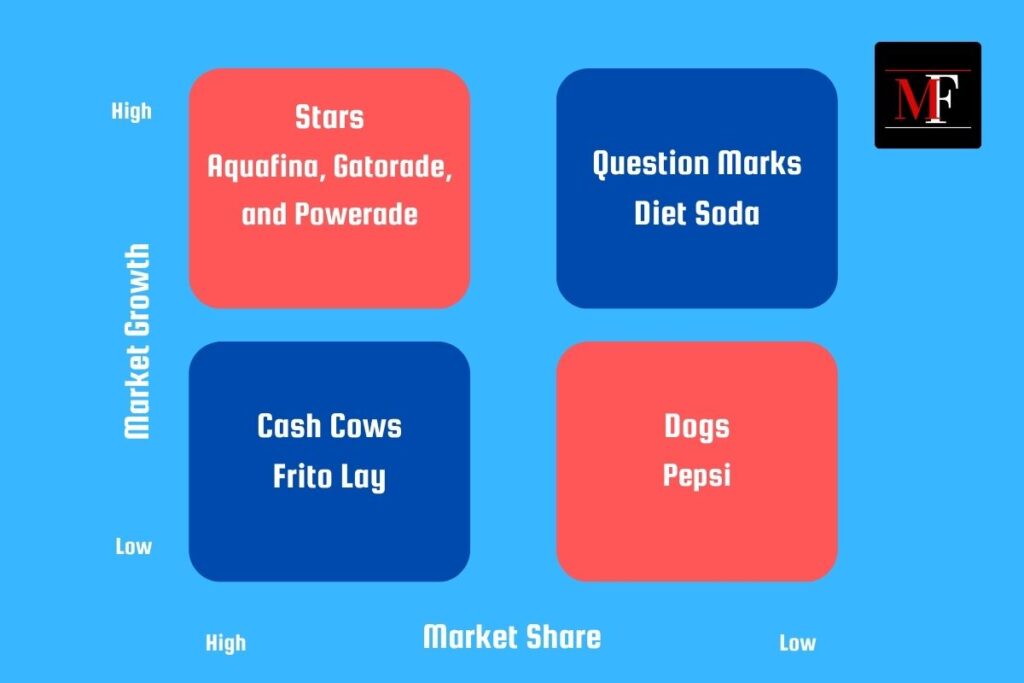The Growth-Share matrix, also known as the BCG matrix, examines a business’s market share compared to its competitors and the industry’s growth rate. It consists of four quadrants: Stars, Question Marks, Cash Cows, and Dogs.
PepsiCo faced a significant decline in its carbonated drinks business, driving a reassessment of its future strategies and product offerings. This process often involves the utilization of strategic planning frameworks such as PepsiCo’s own version of the BCG matrix.
Here is a detailed analysis of the BCG matrix of PepsiCo, but let’s have a look at the company’s brief history.
A Brief PepsiCo history
PepsiCo stands as one of the leaders in the beverage and food industry, having a portfolio of approximately 200 products.
Its origins trace back to Pepsi-Cola, founded by Caleb Bradham, a pharmacist, in 1898. Initially introduced as Pepsi-Cola, the sweet beverage gained popularity but encountered significant challenges post-World War I.
In 1931, a revitalized Pepsi-Cola emerged under Charles G. Guth, who acquired the company’s assets and trademarks. Throughout the 21st century, PepsiCo expanded its reach to various regions worldwide, including Russia.
In this article, we will explore PepsiCo’s BCG Matrix by focusing on its diverse product range, which may not be familiar to all readers. This examination offers insights into the company’s product line and its strategic positioning within the market.
PepsiCo BCG Matrix Analysis

Stars
Products in this quadrant fall in high-growth markets and possess a significant market share. Stars indicate promising growth prospects, backed by their substantial market share, making them attractive investment options for investors looking for enhanced sales and revenue potential.
In PepsiCo’s BCG matrix, notable Stars include Gatorade, Aquafina, and Powerade. Aquafina, a purified water brand, has a market share of approximately 15%. It is steadily closing the gap with its leading competitor and is expected to increase its growth by 2x in the foreseeable future.
Meanwhile, both Powerade and Gatorade dominate the sports drink segment for PepsiCo. The rising consumer preference for healthier alternatives excites companies like PepsiCo to prioritize investments in nutritious food and beverages.
Question Marks
Question marks are the products or services with low market share yet show high growth potential. These products typically reside in the developmental stage of their lifecycle, presenting opportunities for increased revenues if they can reach a Star position.
However, they also pose a risk of becoming liabilities for the company. Effective product development is necessary to capitalize on the potential success of these Question Mark products.
Analyzing the Pepsi BCG matrix indicates that Diet Coke shows promise for establishing a robust market position. While the current market for diet sodas may be limited, the prevailing trend toward healthier lifestyles creates opportunities for PepsiCo to devise innovative product development strategies and tap into emerging markets.
Cash Cows
Cash cows are products that don’t grow much but already have a big market share. They are usually top dogs in the industry and make lots of money for PepsiCo. PepsiCo doesn’t have to spend a lot to keep them on top.
For example, Frito Lay snacks have a big market share in the US, and PepsiCo doesn’t need to invest heavily to stay ahead of competitors.
Dogs
The final section of Pepsi’s BCG matrix represents Dogs—products that were expected to grow but failed due to slow market expansion. Consequently, they don’t contribute much to the company’s sales and become burdensome. The company may either discontinue their production or continue manufacturing them to at least break even.
Interestingly, Pepsi itself falls into the Dogs quadrant of the Pepsi BCG matrix. Despite being a well-known brand since its introduction, Pepsi’s popularity has waned over the years.
While some consumers still favor Pepsi, its demand isn’t as high as it once was, largely due to the increasing preference for healthier, low-calorie beverages.
Given the current trend toward beverage health consciousness, Pepsi is likely to remain in the Dogs section of the BCG matrix for the near future.
Summing it up
The BCG matrix serves as a valuable tool for gaining insights into the performance of a company’s services or products across different markets. Moreover, it enables companies to evaluate strategic investment opportunities aimed at boosting sales and revenue. Additionally, it provides a graphical representation that aids companies in optimizing and preserving their leading positions within the industry.
